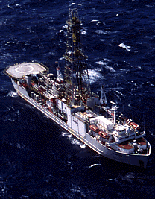
JOIDES Resolution Tour: About the Ocean Drilling Program
The Ocean Drilling Program sponsors an international partnership of scientists and governments to explore Earth's structure and history beneath the seafloor.
WHY DO SCIENTISTS DRILL?
Water covers more than 70 percent of Earth's surface.
Geoscientists explore the oceans to better understand
Earth's fundamental processes.
-- Earth's surface constantly changes and evolves. Drilling
into oceanic crust allows scientists to learn more about
forces such as volcanoes and earthquakes, which have direct
consequences to society. They also investigate other changes
in Earth surface such as ocean crust formation and
destruction, mountain building, and margin subsidence and
uplift.
-- Earth's sea level constantly fluctuates in response to
climatic and tectonic forces. Scientists examine sediments
and rocks recovered from drill sites in the ocean to develop
models of the oceans' history. These models, in turn, can
help countries manage coastal zones.
-- Sediments found beneath the oceans are in part composed
of skeletal remains of plants and animals. Scientists
examining composition of sediments can learn more about
Earth's complex climate system and how the ocean environment
responds to climate changes through time.
ODP constantly refines existing systems and develops new
technology. Current projects include developing systems to
drill into highly fractured formations, to withstand
extremely high temperatures, and to drill deeper into the
ocean's crust than ever before.
FUNDING
The Ocean Drilling Program is primarily funded by the US
National Science Foundation and other
research agencies around the world.
Joint Oceanographic Institutions for Deep Earth Sampling
(JOIDES), an international group of scientists, provides
scientific planning and program advice. Joint Oceanographic
Institutions, Inc., a nonprofit consortium of major U.S.
oceanographic institutions, manages the program.
SCIENCE OPERATOR
Texas A&M University serves as science operator for the
Ocean Drilling Program. The science operator operates and
staffs the drill ship and retrieves cores from strategic
sites around the world. On board the ship, Texas A&M
maintains the laboratories and provides technical and
logistical support for shipboard scientific teams.
On shore, the university manages scientific activities
before and after each cruise, curates the cores, distributes
samples, and edits and publishes the scientific results.
-
Core Repositories
ODP stores core samples for future investigations at four repositories.
-- The East Coast Repository at Lamont-Doherty Earth Observatory in Palisades, N.Y., U.S.A., stores cores retrieved from the Atlantic Ocean through Leg 150.
-- The Gulf Coast Repository at Texas A&M University in College Station, Texas, U.S.A., houses ODP cores from the Pacific and Indian oceans and all special collections such as pore waters.
-- The West Coast Repository at Scripps Institution of Oceanography in La Jolla, Calif., U.S.A., stores all cores retrieved from the Pacific and Indian oceans during the Deep Sea Drilling Project.
-- The Bremen Core Repository at the University of Bremen, Federal Republic of Germany, houses all cores retrieved from the Atlantic Ocean since Leg 151.
Scientists worldwide request samples or visit the repositories to study the cores on site.
Lamont-Doherty Earth Observatory (LDEO) of Columbia University manages wireline logging. LDEO also stores all precruise site surveys in its data bank.
